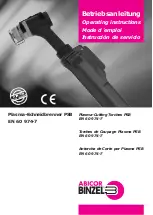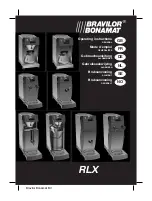
A-2
A.1 PERICOLI
DI
NATURA MECCANICA
A.1.1 RESISTENZA
MECCANICA
Vengono elencati i principali pericoli
legati alla non osservanza delle con-
dizioni di lavoro previste nel manuale
d’uso:
Range di temperatura ambientale
- Infragilimento della struttura della gru
- Troppo bassa/ eccessiva viscosità
dell’olio idraulico
- Surriscaldamento olio idraulico
- Infragilimento delle parti plastiche
-
Deterioramento tubi flessibili
(-40°C
100°C)
Pendenza massima
- Rotazione gru non effettuabile
- Pressione eccessiva nell'impianto di
rotazione
- Sovratensioni
nell’accoppiamento
pignone-cremagliera o ralla-motore
- Sovratensioni nella struttura della gru
- Perdita di stabilità
Portata massima olio al distributore
- Sovraccarichi della struttura dovuti
all’eccessiva velocità di
movimentazione
- Temperatura dell’olio eccessiva
Velocità massima del vento
- Sovratensioni dovute alla pressione
del vento sulla struttura della gru
- Oscillazione eccessiva del carico
- Perdita di stabilità
Precipitazioni atmosferiche
- Scarica elettrica, elettrocuzione
- Problemi legati al malfunzionamento
generale dell’impianto elettrico
Utilizzo in ambienti esplosivi
-
Infiammabilità di olio idraulico e
componenti plastici
Utilizzo in ambiente marino
- Corrosione precoce di parti strutturali
(cilindri, perni)
- Sovratensioni legate alle condizioni di
installazione fissa/marina
Base di Installazione rigida
- Eccessive forze d’inerzia
- Eccessive oscillazioni del carico
Organo di presa
- Problemi di sovratensioni se organi
diversi dal gancio
Tensione di alimentazione
-
Non corretto funzionamento dei
dispositivi di sicurezza
-
Non corretto funzionamento dei
comandi
Grado di protezione IP
- Avarie al sistema elettrico (sicurezza
e comandi)
A.1 MECHANICAL
HAZARDS
A.1.1 MECHANICAL
RESISTANCE
The main hazards resulting from failure
to follow the operating instructions
described in the user manual are listed
below:
Environmental temperature range
- Weakening of the crane structure
- Hydraulic fluid viscosity too low/high
- Hydraulic fluid overheating
- Weakening of plastic components
- Degradation of flexible hoses
(-40°C
100°C)
Maximum incline
- Crane rotation not possible
- Excessive pressure in rotation system
- Excessive stress on rack - pinion
wheel or thrust block - motor coupling
- Excessive stress on crane structure
- Loss of stability
Maximum oil flow rate to main
control valve
- Overloads on the structure caused by
excessive speed of movement
- Excessive oil temperature
Maximum wind speed
- Excessive stress on crane structure
- Excessive oscillation of the load
- Loss of stability
Precipitation
- Lightening, electric shock
- General malfunctioning of the electric
system
Use in explosive environments
- Flammable hydraulic fluid and plastic
components
Use in marine environment
-
Rapid corrosion of structural
components (cylinders, pins)
-
Excessive stress caused by
fixed/marine installation conditions
Rigid installation base
- Excessive inertia
- Excessive oscillation of the load
Lifting component
- Excessive stress if components other
than hook are used
Power supply voltage
- Incorrect functioning of safety devices
- Incorrect functioning of controls
IP protection level
- Electric system faults (safety and
controls)
A.1 MECHANISCHE
GEFAHREN
A.1.1 MECHANISCHE
FESTIGKEIT
Nachstehend werden die hauptsäch-
lichen Gefahren infolge Missachtung
der im Handbuch vorgesehenen
Arbeitsbedingungen aufgeführt:
Bereich der Umgebungstemperatur
- Versprödung der Kranstruktur
- Zu niedrige / zu hohe Viskosität des
Hydrauliköls
- Überhitzung des Hydrauliköls
- Versprödung der Kunststoffteile
- Beschädigung der Schläuche
(-40°C
100°C)
Maximale Neigung
- Krandrehung nicht durchführbar
- Übermäßiger Druck im Drehsystem
- Überspannungen in der Verbindung
Ritzel/Zahnstange oder Dreh-
verbindung / Getriebemotor
- Überspannungen in der Kranstruktur
- Stabilitätsverlust
Max. Öldurchfluss am Steuerventil
-
Überlastung der Struktur infolge
übermäßiger Bewegungsgeschwindig-
keit
- Zu hohe Öltemperatur
Max. Windgeschwindigkeit
- Überspannungen durch den auf die
Kranstruktur einwirkenden Winddruck
- Übermäßiges Schwingen der Last
- Stabilitätsverlust
Atmosphärische Niederschläge
- Elektrische Entladung, Stromschläge
- Probleme im Zusammenhang mit dem
allgemeinen Fehlbetrieb der elektri-
schen Anlage
Verwendung in explosionsgefähr-
deten Bereichen
- Entflammbarkeit von Hydrauliköl und
Kunststoffteilen
Verwendung in maritimer Umge-
bung
- Vorzeitige Korrosion von Struktur-
teilen (Zylinder, Bolzen)
- Überspannungen aufgrund der festen/
maritimen Installationsbedingungen
Starre Installationsbasis
- Übermäßige Trägheitskräfte
- Übermäßiges Schwingen der Last
Greifgerät
- Überspannungsprobleme bei anderen
Greifgeräten als Haken
Versorgungsspannung
-
Nicht einwandfreier Betrieb der
Sicherheitseinrichtungen
- Nicht einwandfreier Betrieb der Steue-
rungen
Schutzart IP
-
Defekte am elektrischen System
(Sicherheit und Steuerungen)
Summary of Contents for AMCO VEBA 810MF
Page 2: ......
Page 10: ...A 1 A MANUALE AVVERTENZE A WARNING MANUAL A ANWEISUNGSHANDBUCH...
Page 49: ...B 1 B MANUALE D USO B OPERATING MANUAL B BEDIENUNGSHANDBUCH...
Page 87: ...C 1 C MANUALE DI MANUTENZIONE C MAINTENANCE MANUAL C WARTUNGSHANDBUCH...
Page 96: ...D 1 810MF D ALLEGATI D ENCLOSURES D BEILAGEN...
Page 138: ......












































